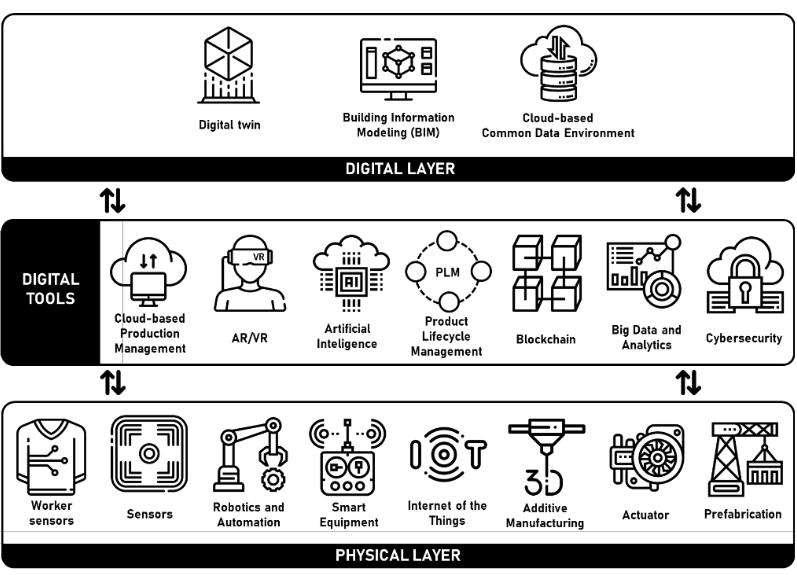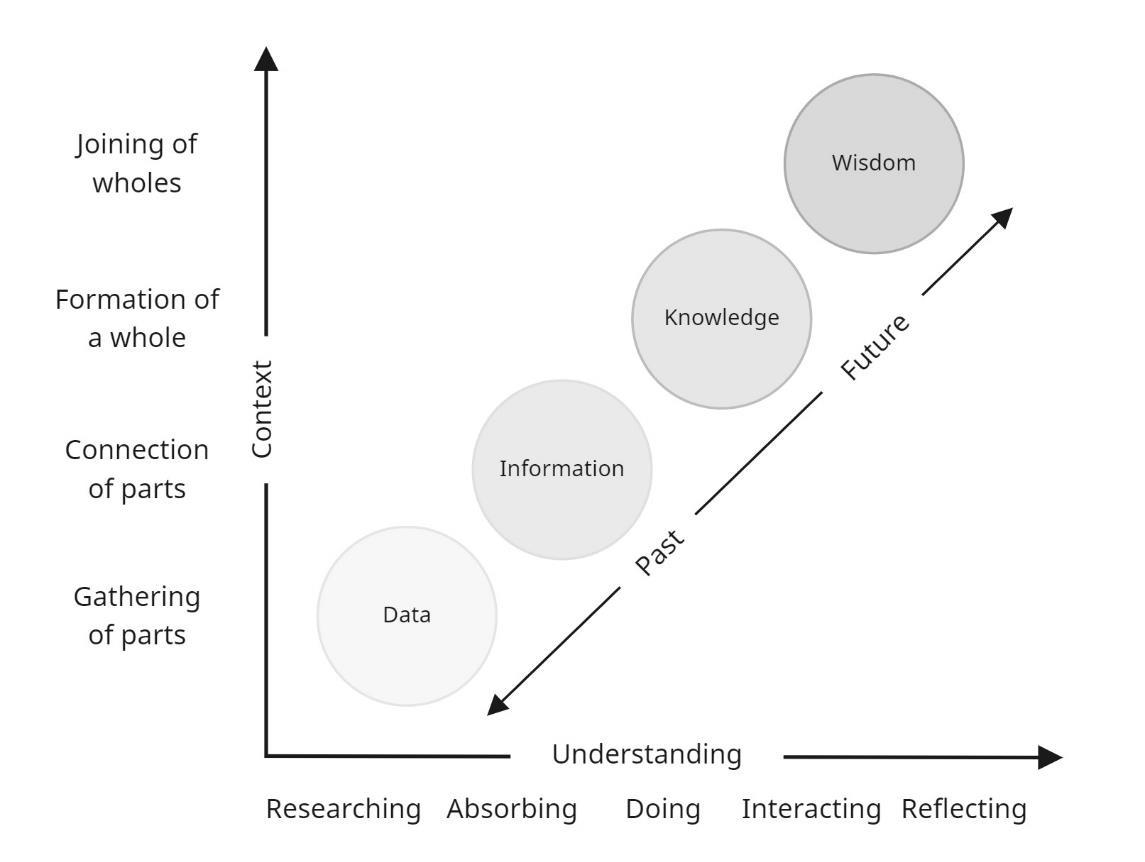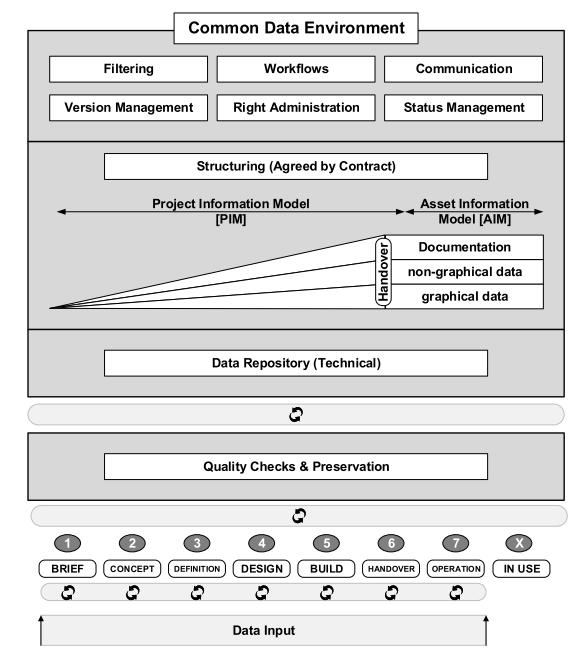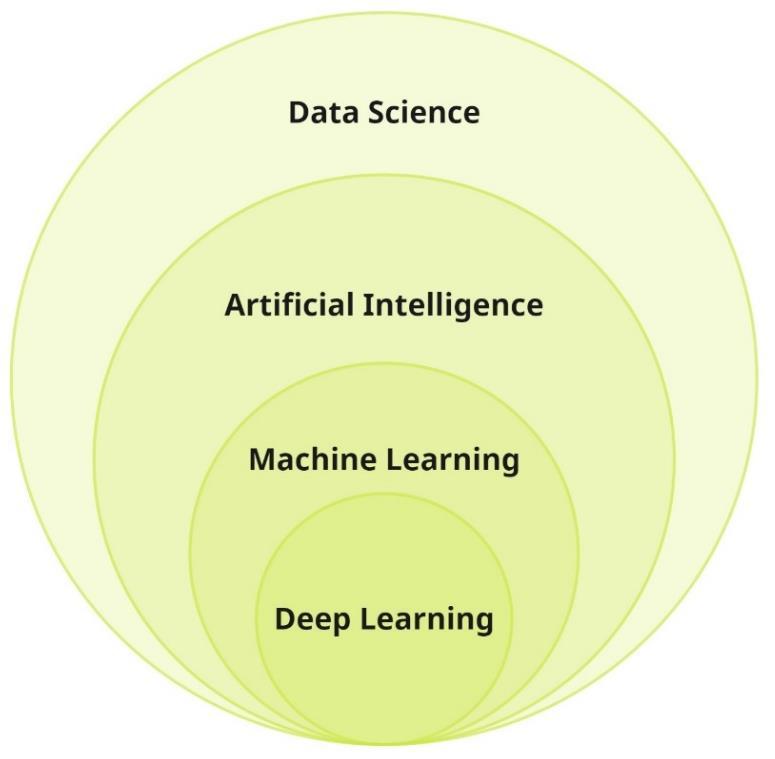
13 minute read
2. DATA IN THE CONSTRUCTION INDUSTRY
Digital development is a concept that has existed for many years in the construction industry. With the development of digital technologies, the speed of digitalization accelerated during the last few years. With the growth of the project sizes, increasing accessibility of technological devices, supporting standardization and legal backgrounds, and the possibility to involve and benefit all the stakeholders, the stage of digitalization became closer. Building Information Modelling (BIM) became a significant component of the digital evolution process with the various software and technologies connected to it (Wyman, 2018).
However, Data can be considered as a principal constituent of the digitalisation process. Within the recent developments in the AEC industry, a large amount of data became available. Compared to traditional data transferring and storage techniques, the modern digital data types can be more reliable and suitable for further development of the projector processes. After the proper data collection and engineering processes, the data can be beneficial and have considerable impacts on digital development in the AEC industry.
Advertisement
2.1. Construction 4.0
The general concept of Industry 4.0 is based on the idea of the Digital Revolution, where the main objective is the connection between people and technology. The Digital Revolution process involves many disciplines, including construction, and in that context, it can be identified as the involvement of Information Technology in construction, manufacturing, fabrication and other operations related to the industry (Alaloul et al., 2020). Nevertheless, despite the apparent benefits of digitalisation, the construction industry still falls behind in adopting Industrial Revolution 4.0 (IR 4.0).
Figure 2 – Themes of Construction 4.0.: Construction 4.0 – Innovation Platform (Adapted from (Vandegrift, 2020))
The technologies in the construction industry have different maturity levels based on IR 4.0 concept. "Technologies such as BIM, Cloud Computing, and Modularisation have developed significantly while other technologies such as Augmented, Virtual and Mixed Reality are still being enhanced and somehow influence the sustainability in the industry" (Alaloul et al., 2020).
Construction 4.0 is a sub-domain of Industry 4.0 that benefits from the progress and general concepts of IR 4.0 in the construction industry (Forcael et al., 2020). Even though researchers started to use the terms Construction and Industry 4.0 together starting from 2014, Construction 4.0 (C 4.0) as a term was
first used by Berger (2016) and became prevalent over the recent years (Forcael et al., 2020). Thus, even though no unified definition of Construction 4.0 exists, it is commonly accepted as a paradigm of digitalisation focusing on BIM and Common Data Environment (CDE) with the application of Data Science and IoT techniques (Sawhney, 2020). Vandegrift (2020) identifies the main topics of Construction 4.0 as people, processes and practices and new technologies (Figure 2).
In general, Construction 4.0 can be broadly identified by three main transformation trends: (i) industrial production and on-site construction: digital fabrication, 3D printing, manufacturing and assembly automation; (ii) cyber-physical systems: robotics and automatised production used in construction site; (iii) digital technologies: integration with AI, Big Data, Cloud Computing, laser scanning, Data Science, Blockchain, Augmented Reality and other technologies related to Data and Computation (Vandegrift, 2020).

Figure 3 – Construction 4.0 framework (Source: (Sawhney et al., 2020))
Based on the literature review Sawhney (2020) illustrated three layers of the C 4.0 framework, as shown in Figure 3. The digital layer consists of BIM, CDE and Digital Twin1 technologies; BIM can be considered a primary component for providing modelling and simulation features, and CDE provides the information flow and repository (Sawhney et al., 2020). The physical layer consists of components that facilitate and digitalizes the processes in the construction site. The digital tools layer is the middle layer that interacts with two others and basically consists of technological tools that can be used in
1 “…a virtual copy of the physical production system …” (Vandegrift, 2020).
digitalization in the construction industry, such as Artificial Intelligence, Big Data, Augmented Reality, Blockchain and others.
Benefits of the implementation of the Construction 4.0 framework were compiled by (Vandegrift, 2020), and can be summarised as reduction of time, costs and energy consumption and the improvement of the quality, cost and time predictions, safety, collaborative environment with the focus on lifecycle assessment and end-result.
2.2. Data in the AEC industry
Data is one of the major concerns of many areas nowadays, including the construction industry. Notwithstanding, with the development of BIM, the construction industry started to deal with an immense amount of graphical and non-graphical data. Not surprisingly, data management also creates both opportunities and challenges for the users. Advanced intelligent computational techniques in data science enable opportunities to investigate areas to effectively use this data (Bilal et al., 2016). Although, the process of collecting, organising, processing, and presenting data is still among the top challenges experienced in the construction industry. Perhaps, for this reason, construction and architectural processes benefiting from the current digital revolution trends, particularly from data science approaches, are still behind other sectors (Alaloul et al., 2020).
The role of data in contemporary design and construction is among ongoing discussions. Contemporary buildings with complex geometries are created using data, mathematical formulas and algorithms, but there is more that data can enable. Substantial benefits of data-driven design and construction are: increasing of building performance, including energy and sustainability goals; affecting operational phase with full lifecycle assessment; increases financial benefits of the projects for both owners and designers; eliminates human factor in critical decision making within providing an optimal solution; helps predict and anticipate consequences of the proposed workflow, to name a few (Deutsch, 2015). Implementing data-driven techniques can also include implementing real-time values, as feedback from the inhabitants and environmental information. Together with assumed values (assumed information for the analyses), real-time values (direct information obtained from sensors or as feedback) are inscribed in the information that can be used for different analyses (Bier and Knight, 2014).
To discuss the concept of digitalization in the construction industry, the framework of transformation from the data to information and then the final steps from the information to knowledge and wisdom should be explored; because the data, as the smaller enabler unit for digitalization, is not fully useful enough by itself. Therefore, the next paragraph explores the concepts behind this reasoning.
The data consists of units (numbers, texts) without relationship or meaning without context; information appears when there is a link and meaning between those units; the information becomes knowledge when this relationship is analysed and understood within some particular context (Pohl et al., 2014). Figure 4 illustrates this framework in the chart created by Clark(2004). The author explores the concept (from the data to the wisdom) in two dimensions: context and understanding, within the time scope (from the past to the future). The data in the chart is represented by researching and gathering parts; the information is described by connection and absorbing of the data; the knowledge is represented by the formation of a whole and interacting, that can be understood as further use of the information; joining
of gathered knowledge as a “whole”s and reflecting as feedback from the wisdom forms wisdom in terms of the current graph.

Figure 4 – Chart representation of the framework from the Data to Wisdom. (Adapted from (Clark, 2004))
The chart represented in Figure 4 can be a base for establishing the construction industry's data management process and the main solution workflow for the problems identified and described in the next paragraph.
2.2.1. Digitalisation challenges in the construction industry
While going through the general emerging data consumption and production tendency, two main obstacles can be observed: technical and analytical problems with data structure and size; and ethical and regulatory problems (Engin et al., 2020). Despite the trend of digitalisation altering in the various industries, its adoption by the construction industry is still slow. Several aspects can be seen as an identification of the problem, such as involvement of many stakeholders in the process, fragmented data and supply chain, lack of big picture vision, uncertainty, along with others (Alaloul et al., 2020).
Hall et al. (2020) suggest fragmentation as a primary challenge the construction industry faces during innovative development. Traditionally the fragmentation in AEC industry is divided into horizontal: between different competitive firms providing services; vertical: division of the production by several specialised parties; and longitudinal: the fragmentation between the service providing parties and the client (Fergusson and Teicholz, 1993; Howard et al., 1989).
Soman and Whyte (2020) organize problem findings on data quality by the following dimensions: accuracy, completeness, timelessness, consistency, accessibility and data provenance. The study
identified several codification (presenting machine-readable data/information) challenges that are related to software usage, information sharing and construction process information. Codification problems also slow the adoption of data science techniques by the construction industry (Soman and Whyte, 2020).
Another challenge any novelty and digitalization attempt face is an aversion of acceptance changes due to a conservative point of view. The investors are averse to upfront investment due to the high cost at the beginning of implementation (Vandegrift, 2020).
2.2.2. Role of BIM models in data management
A critical technical question to answer is to what extent BIM models, one of the most important repositories of information in the construction industry, play a central role in facilitating data management. Thus, the availability of the data by itself does not improve design or construction processes. Data collection and followed by data engineering processes create a background for the learning process. The transformation from the data to information includes numerous steps to conclude with the challenges appearing in each step.
The central objective of BIM is “ …to create a collaborative environment by providing interoperability and consistent data structure” (Huang et al., 2021, p. 12). Information in the BIM model is usually split into several models by different disciplines (e.g. architectural model, structural model, MEP model), which are connected in a federated model (Noardo et al., 2021).
Implementation of BIM models benefits the dismission of data loss during the project creation, as there is no file exchange, and each team can reference in their part of the contribution to the model (Elmualim and Gilder, 2014). However, storing the BIM data in native formats poses difficulties in the further workflow of reusing that data (Belsky et al., 2016).
The increasing amount of data and complexity of tasks creates difficulties for the individuals to deal with, and there were proposed two main solutions for this issue. The first solution is applying standardisation methods in architectural and construction processes; along with reducing the complexity of the tasks, it can result in monotonous and heterogenous output. The second solution is to involve a collective learning process in the construction industry. Collective learning can enrich the tasks, involve innovative solutions, increase individual and organisational maturity levels. Learning types are broadly separated into individual and organizational (as the next step of previous) learning—the amount of learning increases by increasing the willingness to share. There are several types of individual learninglearning through experimenting, reading, organising, construction, or attending educational seminars. The main difficulty in establishing organizational learning is forming a unified project culture between different groups (teams), which can also cause the lack of interaction between them (Wasif et al., 2003). The concept of learning from a technological point of view will be expanded in Chapter 3.
2.2.3. Maturity levels in digitalisation: standardisation and interoperability
Standardisation can be considered as one of the foundations of the developments in the industry. Vandegrift (2020) considers the lack of standardisation as one of the main factors that decelerate the digitalisation processes within the framework of Construction 4.0. However, a considerable
improvement in interoperability was made by introducing and improving the IFC standard; there is still a gap in embracing standards in data and processes.
2.2.3.1. Open-source schema for BIM – IFC
IFC (Industry Foundation Classes) is an open-source compound schema for BIM model representation created by the buildingSMART organisation in 1997 (BuildingSMART, 2021). It is a richly extensive schema used for file exchange in BIM (Belsky et al., 2016).
The development of the IFC schema with the specific semantics with hierarchic data structure will enable an evolution towards a more advanced setting for data management in the AEC industry and further enable ML to access more expansive databases for the learning process. The use of native models lowers interoperability, which can be avoided by integrating IFC that provides an equal footing for different software providers. The IFC is used for interoperability between different datasets, different fields or different formats (Noardo et al., 2021)

Figure 5 – IFC data structure (Source: (BuildingSMART, 2020))
The data structure in the IFC file includes the objects, their attributes and semantics, relationships between the objects, concepts (such as costs, performance etc.), processes (such as installation, demolition, operation etc.) and stakeholders of the project (BuildingSMART, 2021). Nowadays, the IFC standard is mainly used for model exchange between different parties (BuildingSMART, 2021) and for interoperability between different software (primarily for structural analyses and clash detection).
The underlying structure of IFC was presented in Figure 5; the IFC are organized into four layers: a domain layer, an interoperability layer, a core layer and a resource layer. The domain layer is the highest layer that includes the domain-specific information about the model (e.g. IfcArchitectureDomain, IfcConstructionMgmtDomain, IfcHvacDomain). The interoperability layer includes specific information about a product, a process or a resource (typically used for interdisciplinary exchange). The core layer contains more general and central data in the model; the kernel, in particular, defines the objects, relationships and properties (e.g. IfcRoot, IfcGroup, IfcActor). And finally, the resource layer is the lowest layer and includes further descriptions of an object after the defined layers (cannot be used independently) (BuildingSMART, 2020; Noardo et al., 2021). The elements belonging to the higher layer of an IFC file can refer to an element from the lower level, but the opposite is not possible (Eschenbruch and Bodden, 2018).
2.2.3.2. The role of Common Data Environment in interoperability
Common Data Environment (CDE) is one of the key components in integrating the Construction 4.0 framework. Sawhney (2020, p. 306) identifies the CDE as an “ …independent and application-agnostic repository of data of the constructed asset over its life”. Implementing a common data environment provides fast and smooth data flow between the stakeholders (Vandegrift, 2020); this can improve the quality of information by making data more reliable, easy to access, and easy to collect. As CDE also improves an interdisciplinary interaction, the data extracted from CDE can create a diverse dataset, which can be implemented in a solution of various problems. The accessibility of the data (within the increased quantity and quality of the data) can support the use of Machine Learning algorithms with their application on Building Information Models.
To understand at what level CDE can facilitate Machine Learning implementation, it is essential to investigate the layered structure of CDE. Figure 6 illustrates the general structure of CDE in the form of a hierarchic graphical representation of the concepts discussed above. It is a layered structure that consists of individual technical elements (Borrmann et al., 2018).
The primary mission of CDE is to establish a data repository system that is basically a technical space used for data storage. There are no specific requirements for the location or used technologies for that storage, but the increasing amount of data with developing BIM technologies within years should be considered. A central data storage also reduces the risk of data loss and keeps the data updated, increasing data quality. A data structure is another critical aspect to consider in establishing a CDE; the data structure should be agreed upon at the beginning of the project and can be hierarchically grouped for more efficient management. Successful data management also enables processes of automation (e.g. clash detection, model checking) (Borrmann et al., 2018).






